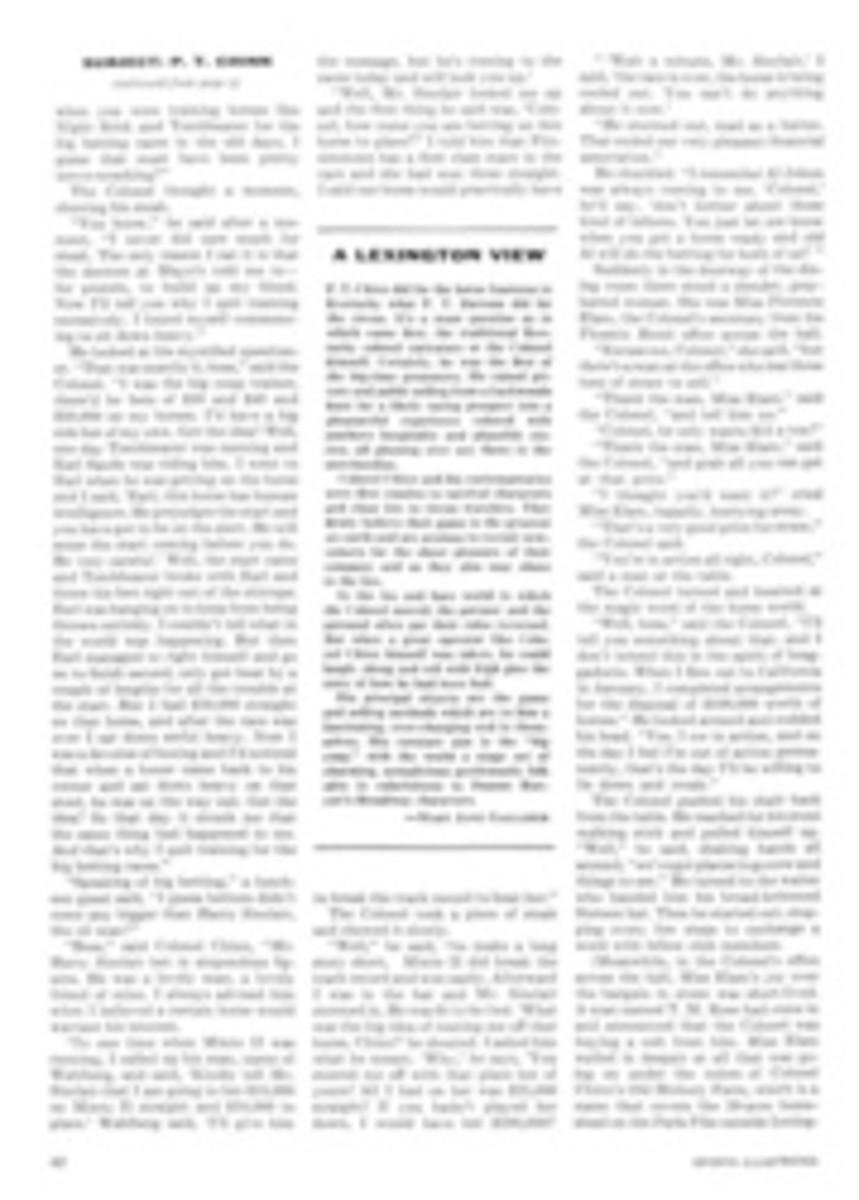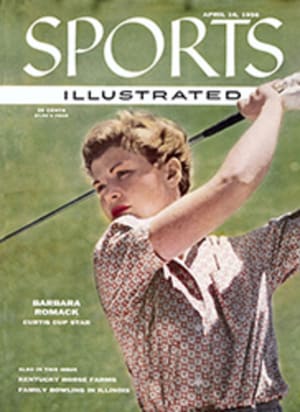
THE OLYMPIAN FIELDS OF MOSCOW
It takes but one fast glance down the Moscow River valley from the escarpment in front of Moscow University's 38-story skyscraper to realize that Russia is not merely out to cop the Olympics in Melbourne in 1956 but that it will make a bid to win them on its own territory in 1964.
As the April thaws dissolve the white satin comforter that has lain over the Lenin Hills and the Luzhniki suburbs since last fall, a vast park of nearly 350 acres splotched with the skeletal forms of the most ambitious sports plant ever built in Russia, in Europe and perhaps in the world is revealed for the first time.
Construction crews aided by volunteer flying squads recruited from the Soviet Union's most famous athletic aggregations are swarming over the developing shapes of a stadium that will seat 100,000, an open-air swimming pool with seats for 13,200, a small stadium to hold 15,600, and a covered arena that will seat up to 17,000.
Under the melting snows that run down the embankment now to swell the curving Moscow River are the outlines of eight football fields, 30 tennis courts, 17 volleyball courts and 15 basketball courts. Soviet athletes will be able to compete and practice in 24 sports at the same time. A playing area, separate and complete, is being built for children. An international youth athletic festival is on the books for 1957.
But the reason for the immediate rush—the work schedule for the giant project has been pegged at 23 months—is the giant sports show being planned for this July. A mammoth spartakiad will bring together some 10,000 of the best athletes culled from the 16 Soviet republics. They will fight it out in a program of 165 matches. The winners, sifted from all-Russia's best sports talent, will have plenty of time to catch a slow boat for Melbourne where the Summer Olympics begin in November.
Soviet athletes in from the far Asiatic provinces, Tartars up from the Kazan, indeed, even sophisticated Muscovites all converging on the sports center for the old collective try this summer, can hardly but be dazzled by this razzle-dazzle sports extravaganza. Above the seats of the main stadium, for instance, will be a circular deflector. The device has been designed to shade the football field during playing hours which vary from month to month. It will also hold 500 floodlights for night football games and provide illumination for television and newsreels. Simultaneously it will help protect the arena from strong winds blowing across from the Lenin Hills. As Soviet sports officials point out, a wind velocity of more than 6.6 feet per second would make track records inaccurate.
The Russians are trying out a new gimmick in the smaller stadium, too. First-row spectators have been elevated one tier so as not to distract the players. As the Russian magazine Sporting Games indicates, "The calm white walls surrounding the arena will further help the players to concentrate on the game." Nor will teams be distracted by warming up on the playing fields. A pair of warmup halls is being built under the stadium. And when the game is done, a player will not merely repair to the showers; he may relax like a tsar, or a quota-meeting worker, in an oversized bathtub with a built-in seat.
A battalion of architects under the direction of Alexander Vlasov, the man who executed a 100-yard dash from New York back to Russia last year after being accused of overdecorating Moscow buildings, has designed a waterfall which will cascade over the outside wall of the swimming-pool stadium. However, they have also thought to install a functional heating system under the pool which will permit water-polo teams to practice seven months a year. A freezing system in the covered arena will permit hockey players to disport themselves in summer. Playing hockey in the frostbite temperatures of a Russian winter never bothered a Russian, but it has severely hampered foreigners. A team from Britain played in the open-air Dynamo Stadium last winter before a crowd of 11,000 who sat in the unprotected stands in a temperature of 26 below. Cognac and wine were sold in the interests of self-preservation, but the situation wasn't serious enough to permit the sale of vodka.
Until now Moscow has never had a big indoor arena. Indoor events—boxing, for example—are usually staged in the Circus at a time when the troupe is off playing in the hinterlands. When Sonja Henie came barreling into town from Oslo intent on staging her ice show in Moscow, the Circus was busy playing the circus. When Miss Henie suggested requisitioning the Bolshoi Theater, that hallowed gold-and-plush auditorium sacred to the concert and ballet, the Russians were aghast.
The new covered stadium, completely air-conditioned, can hold as many as 17,000 spectators, depending on the games, and it will be larger than the Paris Vélodrome d'Hiver. A roomy training room can be converted into a meeting room at a moment's notice, and a collapsible platform can be raised in the main hall for mass meetings.
In the Russian athletic scheme, the arena under the stands is not merely a place to decide partisan feelings. The space under the main stadium is being divided into four floors each girded by a circular passageway wide enough to drive an electric car. On the top floor there will be lodgings for 340 competitors as well as a pressroom connected to the press box in the stands. The third floor will house eight gymnasiums, a conference hall for 250, two movie theaters each holding 250, a restaurant for 300, and a café for 300.
The comfort of the Socialist Soviet spectator seems to have become a prime consideration. Five thousand citizens can eat at one time in the restaurants, snack bars, mobile kitchens and local automats. It will be quite an improvement over the situation this winter when I watched youngsters ski along a path to Dynamo Stadium en route to a hockey game, stop to buy snow-dusted, cream-stuffed crullers from a snow-dusted lady vendor. Between halves of the game (played with a ball and curved sticks) between the Sverdlovsk Officers Club and the local Dynamo team, a spectator could stave off hunger with an 81¢ orange or a 90¢ chocolate bar.
In the Luzhniki sports center there will be tonic, too, for the Soviet soul. Burbling fountains will delight the ear, decorous pools will relieve the eye, leafy trees will shade the brow. Frescoes will decorate the principal buildings and wide promenades will lead down to the banks of the river.
A spur line of Moscow's famed subway is being extended to accommodate the university and the sports center. The Moscow River will be widened and a higher elevation provided for the park as a protection against spring floods. Boat races will be held on the river and piers are being installed "for the use of visitors in attaching their vessels." Not only will there be free parking for the comrades' yachts, but, says the Soviet architectural journal, "luxurious lawns will serve as a background for the calm and bright outlines of the sports buildings.... This," the magazine concludes, "will create a feeling of triumph and glory." With all this new equipment, it would seem that Ivan is at last ready to play for keeps.
PHOTO
MAP
1
2
3
4
5
6
7
8
PHOTO
ARTIFICIAL ICE RINK, SPECTATOR STANDS AND THE GALLERY ABOVE ARE SHOWN IN THIS SOVIET DRAWING OF THE NEW COVERED GYMNASIUM
FOUR DIAGRAMS
PHOTO
CHIEF ARCHITECT Alexander Vlasov (center) looks over an earlier project, the rebuilding of Kiev, with his two assistants.
WHAT THE PICTURE SHOWS
In Alexander Leydenfrost's drawing, based on official Soviet drawings and photographs, the view is across the main area of the new sports center toward Moscow. Across the river, linked to the area by a broad avenue, is Moscow University (l), flanked by the Lenin Hills (2). The Moscow River (3) will be widened and channeled. To the left is the swimming stadium (4), at center the main stadium (5), with the stadium for handball and other sports (6) at right. At lower right is the covered gymnasium (7), and scattered over the entire area are football fields, tennis courts, track-meet areas and other facilities together with decorative walks and pools. Moscow itself (8) looms in the distance.
OFFICIAL PLANS OF THE FOUR STADIA
Handball court stadium also provides for many other sports. Arena measures 264 by 132 feet, with provisions for 200-by-99-foot artificial rink and special entrance for automobiles directly into arena. There are 25 rows of stands, café, snack bars, two large training rooms at the disposal of contestants.
Covered gymnasium will be one of world's largest. The arena measures 200 by 99 feet and can be used for all kinds of sports events, including ice hockey. Special features are an elevated track and a collapsible platform for concerts, lectures or meetings. The entire gymnasium is air-conditioned throughout.
Swimming stadium has two pools, one (22 by 25 meters) for diving, another (equivalent to 55 yards) for racing events. Below stands is a heated area for swimmers, with two large gyms, locker rooms, medical room and snack bar. It also features small instruction pools and full facilities for training.
Main sports stadium is designed for year-round use for anything from track meets to mass physical culture. It has a football field in center, a 400-meter (equivalent of 440-yard) track and four track meet areas. Spectators enter on second floor, descend to a circular ramp and thence via 12 staircases to seats.

